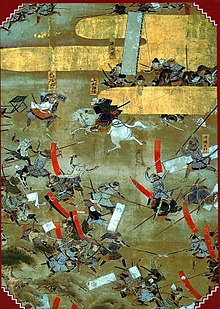Ko-ryū
| Ko-ryū | |||||
|---|---|---|---|---|---|
 Centuries of feudal warfare in Japan, and the desire to perfect the skills for war, led to the creation of the traditional schools of Japanese martial arts. | |||||
| Japanese name | |||||
| Kanji | 古流 (Koryū) or 古武道 (Kobudō) | ||||
| Hiragana | こりゅう | ||||
| |||||
Koryū (古流, old style, old manners, old school) and kobudō (古武道, ancient martial ways[1]) are Japanese terms that are used in association with the ancient Japanese martial arts or classical martial ways. The term is contrasted with shinbudo or Gendai budō, or "modern military arts", a term used for schools developed after the Meiji Restoration.[2][3]
Description of Koryū
This term literally translates as "old school" (ko—old, ryū—school) or "traditional school". Koryū is also a general term for Japanese schools of martial arts that predate the Meiji Restoration (1868) which sparked major socio-political changes and led to the modernization of Japan.[4]
The system of koryū is considered in following priorities order: 1) combat, 2) discipline 3) morals.[5][6]
Description of Kobudō
Kobudō (古武道, kobudō) is a Japanese term for a system that can be translated as 古(old) 武(martial) 道(way) "old martial way"; the term appeared in the first half of the seventeenth century.[7] Kobudō marks the beginning of the Tokugawa period (1603-1868) also called the Edo period, when the total power was consolidated by the ruling Tokugawa clan.[8]
The system of kobudō is considered in following priorities order: 1) morals, 2) discipline 3) aesthetic form.[9][10]
Distinction
Some organisations, for example All Japan Kendo Federation,[11] mixs the term kobudō 古武道 together with the term ko-ryū 古武道 while some societies, for example International Hoplology Society, makes a distinction between kobudō and ko-ryū concerned the origin and the difference between the ranking of priorities concerning combat, morals, discipline and/or aesthetic form.[12]
Okinawan kobudō
Kobudō must not to be confused with Okinawan kobudō which may be used to describe collectively all Okinawan combative systems. These are entirely different and basically unrelated systems. The use of the term kobudō should not be limited, as it popularly is, to the describing of the ancient weapons systems of Okinawa.[13][14]
Han
During the feudal period of Japanese history, many koryū schools were the otome-ryū (literally, "that which flows but remains at home") of the han (domain). Being an otome-ryū entailed that the heads of these ryū (schools) would get a rice stipends from the han's total koku (a unit of measurement used to calculate rice revenues and used to measure the relative wealth of a han) in exchange for training the samurai of the han. However, there were exceptions to being funded by a specific han, and many ryū were never or only partially supported by a han. For example, Tenshin Shōden Katori Shintō-ryū was solely supported by donations from local landed bushi and was never attached to a specific domain. Likewise, Maniwa Nen-ryū was founded and supported by the peasant farmers of Maniwa village in Gunma Prefecture, as a means of village protection. A third example is Kashima Shin-ryū which took its name from a famous Shinto shrine which would acquire funds to support itself from taxing the activities associated with lands owned or regulated by the temple, as well as serving as hereditary guardians of the Kashima Shrine. These kinds of arrangements therefore allowed the heads of schools to devote themselves full-time to teaching in the schools, while providing assorted services to the school's benefactors.
It was not until the Meiji Restoration when this almost 500 year arrangement started to fall apart and various heads of schools had to seek other means of employment. Teaching their ryū to the general public was only one of many options. Today, few headmasters of a koryū or kenjutsu school make a living solely by teaching their art, yet through their devotion, many ensure their arts continue to thrive for generations.
Examples of skills taught in koryū or kobudō
See also
References
- ^ Kenkyusha's New Japanese-English Dictionary, Kenkyusha Limited, Tokyo 1991, ISBN 4-7674-2015-6
- ^ Draeger, Donn F. (1974) Modern Bujutsu and Budo. New York: Weatherhill. Page 57. ISBN 0-8348-0351-8
- ^ http://books.google.dk/books?id=sBWasQSsb-UC&pg=PA22&dq=gendai+budo&hl=en&sa=X&ei=-FkSUfX3Oc3Xsgaji4DoAQ&redir_esc=y#v=onepage&q=gendai%20budo&f=false Fumon Tanaka (2003) Samurai Fighting Arts: The Spirit and the Practice. Tokyo: Kodansha International Ltd. Page 22. ISBN 4-7700-2898-9
- ^ Armstrong, Hunter B. (1995) The Koryu Bujutsu Experience in Koryu Bujutsu - Classical Warrior Traditions of Japan. New Jersey: Koryu Books. Page 20. ISBN 1-890536-04-0
- ^ Donn F. Draeger, 1973. Classical Budo. ISBN 978-0-8348-0234-6. Page 36
- ^ Armstrong, Hunter B. (1995) The Koryu Bujutsu Experience in Koryu Bujutsu - Classical Warrior Traditions of Japan. New Jersey: Koryu Books. Page 20. ISBN 1-890536-04-0
- ^ Draeger, Donn F. (1973) Classical Budo. Boston: Weatherhill. Page 68. ISBN 978-0-8348-0234-6
- ^ Knutsen, Roald (2004) Rediscovering Budo. Kent: Global Oriental. Page 22-23. ISBN 1-901903-61-3
- ^ Donn F. Draeger, 1973. Classical Budo. ISBN 978-0-8348-0234-6. Page 36
- ^ Armstrong, Hunter B. (1995) The Koryu Bujutsu Experience in Koryu Bujutsu - Classical Warrior Traditions of Japan. New Jersey: Koryu Books. Page 20. ISBN 1-890536-04-0
- ^ Japanese-English Dictionary of Kendo. All Japan Kendo Federation. Tokyo. Japan. 2000. Page 52.
- ^ Armstrong, Hunter B. (1995) The Koryu Bujutsu Experience in Koryu Bujutsu - Classical Warrior Traditions of Japan. Page 19-20. ISBN 1-890536-04-0
- ^ Donn F. Draeger, 1974. Modern Bujutsu & Budo. ISBN 0-8348-0351-8. Page 135.
- ^ Armstrong, Hunter B. (1995) The Koryu Bujutsu Experience in Koryu Bujutsu - Classical Warrior Traditions of Japan. New Jersey: Koryu Books. Pages 19-20. ISBN 1-890536-04-0
External links
- What is Koryu?
- Koryu.com in English. Provides articles and links to books.
- KoryuWeb in French and English.
